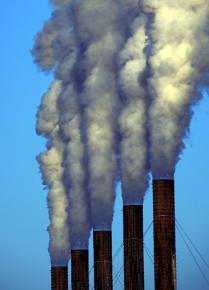The fable of “clean” coal
There are plenty of reasons to be suspicious of the candidates' calls for investment in "clean coal" technology, says .
IN AN otherwise contentious final debate between the presidential candidates, there was one thing John McCain and Barack Obama could agree on: America should be investing in "clean coal" technology to reduce pollution and America's dependence of foreign oil.
Obama has been talking about so-called "clean" coal for more than a year now, and he recently announced the creation of a Clean Coal Jobs Task Force, earning the enthusiastic praise of leaders of the power and mining industries.
There's only one problem: there's nothing clean about "clean coal."
There are about 600 coal-fired power plants in the U.S. They generate more than half of the country's electricity, making billions for the energy companies that operate them and the mining companies that feed them. They are also the single biggest source of carbon dioxide, the main greenhouse gas responsible for global warming.
The supposed solution that Obama supports is called "carbon capture and sequestration" (CCS). In CCS, carbon dioxide is removed from the mix of gases in a power plant's smoke stack, or is chemically extracted from the coal prior to burning. It is then compressed, transported and stored underground in depleted oil and natural gas fields or in saline aquifers.

CCS is currently being used on a small scale at four sites in Norway, Canada and Algeria, and the technology is being tested by several U.S. universities and utilities.
While CCS may sound like an easy fix, there are plenty of reasons to be suspicious.
One obvious concern is that carbon dioxide may leak back out into the atmosphere. Supporters claim to be confident that no more than 1 percent of stored gases will escape, but the fact is that no one knows if the system will really work over the long term.
Even if it does, CCS would be incredibly expensive. Capturing and compressing carbon dioxide would use as much as 40 percent of the energy generated by a power plant, almost doubling the price of the electricity delivered to the power grid. The necessary machinery would sharply increase the cost of building new plants, and it could cost as much as $1 billion to retrofit each of the 600 old ones. Also, a completely new pipeline infrastructure would have to be built to transport carbon dioxide to storage sites.
Not only would CCS cost hundreds of billions of dollars, but the first clean coal plant wouldn't go online until 2020 at the earliest--and it would be a decade more to see the technology implemented on a large scale. Climate scientists agree that global carbon dioxide emissions need to start falling far sooner than that if we are to have any hope of slowing global warming.
Finally, carbon dioxide is just one of the many ways that coal hurts the environment and human beings.
Burning coal also releases mercury and other heavy metals into the atmosphere. Mercury causes irreversible neurological damage and has been linked to autism. Also, the average coal plant uses more than two billion gallons of water a year for coolant, enough to support a city of 250,000.
And finally, surface strip mining of coal destroys millions of acres of habitat, while underground mining is one of the most hazardous and unhealthy jobs there is, killing dozens and injuring thousands of U.S. workers every year.
SO WHY is there so much support for something that seems to be an obvious contradiction in terms?
One reason is the American Coalition for Clean Coal Electricity, which has spent almost $40 million on pro-coal publicity in the last year, buying TV and radio ads and sending public relations teams to the Democratic and Republican conventions and other campaign events. Not surprisingly, the coalition is entirely funded by power and mining companies.
The Obama-Biden campaign have some proposals on energy and the environment that would make sense.
For instance, they suggest taxing Big Oil's windfall profits and using the proceeds to provide an emergency energy rebate to working-class families. They also say they will use oil from the Strategic Petroleum Reserve to reduce prices at the pump, raise federal fuel economy and energy efficiency standards, give tax credits for purchases of advanced vehicles, and create new "green jobs" by investing in renewable energy sources like solar and wind.
Whether these things would actually happen under an Obama administration remains to be seen, since the energy industry will continue to push back against even small reforms if they appear to threaten profits.
Some of Obama's other ideas about energy are not so bright. For one, Obama has said that he is willing to consider a new round of offshore drilling, which would endanger critical marine habitats in the process of extracting a relatively small amount of oil.
Obama also refuses to rule out construction of new nuclear power plants. In addition, he supports the use of a cap-and-trade pollution credit program as one of the main ways to stop global warming--which allows wealthy nations to continue polluting at an extreme rate, while putting a positive spin on their lack of real action in combating global warming.
A real solution to the environmental devastation caused by the burning of fossil fuels, not to mention the question of meeting future energy needs, will take more than voting Obama into office. Real change will require an overhaul of the system--from the way production is organized to the way transportation systems are designed and run.
The fairy tale of "clean coal"--no matter who is telling it--isn't a part of that solution.


